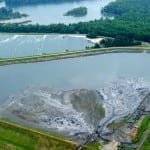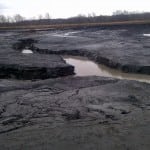The disposal of coal ash, a combustion byproduct from coal-fired power plants, was propelled into the national conversation on December 22, 2008, when the Tennessee Valley Authority (TVA) Kingston power plant suffered one of the largest coal ash spills in history. Calls for regulatory action shifted pitch again after the Duke Energy Dan River spill on February 2, 2014.
[RELATED: Notable Power Plant Coal Ash Spills (Slideshow)]
Here’s a quick look at all that has happened on the coal ash front since the Kingston disaster.
December 22, 2008: The earthen retaining wall of an ash pond at the TVA’s 1,700-MW Kingston Fossil Plant in Harriman, Tenn., collapses, spilling 1.1 billion gallons of coal fly ash slurry. The broken dike is said to have left 4 or 5 feet of water and mud over 250 to 400 acres of rural land.
January 2009: Just weeks after the Kingston spill, 10,000 gallons of gypsum slurry leaks from a break in an impoundment at TVA’s Widows Creek Fossil Plant.
March 2009: Former Environmental Protection Agency (EPA) Administrator Lisa Jackson orders the review of some 300 U.S. utility coal combustion waste sites and says the agency will develop new rules to ensure spills like the Kingston spill are not repeated.
July 2009: TVA Inspector General Richard Moore testifies at a U.S. House subcommittee that the Kingston spill “was caused by regulatory neglect, a lack of government oversight, and irresponsible coal ash practices.”
June 2010: After months of delay and indecision over the appropriate scope of federal regulations, the EPA issues a proposed rule regulating coal combustion ash either as a nonhazardous waste subject to tougher management and disposal requirements or as a “special” hazardous waste that would have similar controls but still be eligible for recycling and reuse in products.
April 2013: The EPA proposes revisions to technology-based effluent limitations guidelines and standards could set the first federal limits on the levels of toxic metals in wastewater discharges from steam electric power plants. The proposed rule would help reduce pollutants in U.S. waterways from coal ash, air pollution control waste, and other power plant waste, but they could come at a cost of between $185.2 million to nearly $1 billion a year, the agency says.
February 2, 2014: A storm drain under a coal ash pond at Duke Energy’s Dan River Steam Station breaks, releasing 39,000 tons of coal ash and 27 million gallons of polluted water into the Dan River. The leak was not plugged for nearly a week because workers needed access to the site of the break to complete repairs.
August 2014: North Carolina enacts the nation’s first comprehensive coal ash management law. The law bans new coal ponds and mandates that “high risk” ponds be closed within five years, that ponds posing an “intermediate risk” are closed by December 2024, and that all the state’s coal ash ponds are closed by December 2029.
December 2014: The EPA issues the Disposal of Coal Combustion Residuals from Electric Utilities final rule, setting the first-ever minimum federal standards for the disposal of coal ash under the Resource Conservation and Recovery Act (RCRA). It means the EPA has elected to classify coal ash as a non-hazardous solid waste subject to regulation under subtitle D of RCRA. However, the rule also calls for the closure of surface impoundments and landfills that fail to meet engineering and structural standards and calls for regular inspections of the structural safety of surface impoundments.
April 2015: Dominion Virginia Power announces it will close all its coal ash ponds at power plants in Virginia to comply with state and federal standards.
June 2015: Duke Energy announces is will close its 12 remaining coal ash ponds in North Carolina, transferring ash to lined disposal sites.
July 2015: Under pressure from environmental groups, including lawsuits, South Carolina’s three utilities—South Carolina Electric and Gas, Duke Energy, and Santee-Cooper—agree to remove all coal ash from unlined pits throughout the state, approximately 20 million tons
September 30, 2015: EPA finalizes revisions to its effluent limitations guidelines and standards. The new rule sets stringent new requirements for the discharge of arsenic, mercury, selenium, and nitrogen in wastewater streams from flue gas desulfurization, and it requires zero-discharge of pollutants in ash transport water.
September 30, 2015: Georgia Power announces it will close all 29 of its coal ash ponds to comply with federal coal ash rules and brand new guidelines governing effluent limitations.
January 2016: Kentucky Utilities says it will spend $678 million to meet federal environmental requirements involving coal ash ponds. Louisville Gas & Electric will spend $316 million to do the same, by capping its remaining ash ponds at Mill Creek and Trimble County generating stations.
—Sonal Patel, associate editor (@POWERmagazine, @sonalcpatel)










